Beekeeping is a rewarding hobby that is vital in preserving our natural ecosystems and ensuring food security. Beekeeping, also known as apiculture, is the art and practice of raising honeybees for various purposes. It involves creating and maintaining beehives where bees can live and thrive. Beekeepers play a crucial role in conserving bee populations while reaping the sweet rewards of their hard work.
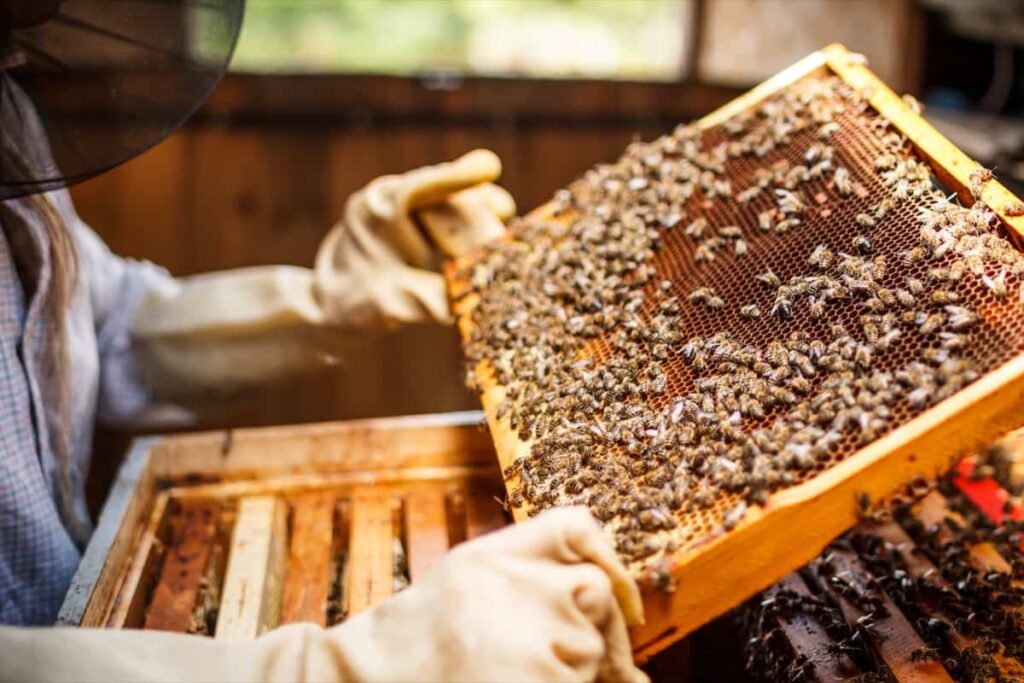
15 Steps to Start Beekeeping in the Netherlands
Importance of Beekeeping in the Netherlands
Bees are crucial in pollinating crops and flowering plants, ensuring their reproduction and yielding bountiful harvests. This vital ecosystem service contributes to maintaining biodiversity and supporting agricultural sustainability in the country. One primary purpose of beekeeping in the Netherlands is to harvest honey. Honeybees diligently collect nectar from flowers and transform it into delicious honey through a remarkable process.
The complex social structure within the hive ensures efficient production, with worker bees responsible for tasks such as foraging, nursing larvae, and protecting the colony. Moreover, beekeeping promotes sustainable agriculture by reducing dependence on chemical fertilizers and pesticides. Bees help control pests and diseases naturally through their diligent work within ecosystems.
Choosing the Right Location for Your Beehives in the Netherlands
It is crucial when starting beekeeping in the Netherlands. The location plays an important role in the success and productivity of your bees. It’s important to find an area with ample flora and diverse vegetation. Bees rely on nectar and pollen from various sources for their nutrition, so having a wide range of flowers nearby is essential.
In case you missed it: 15 Steps to Start Honey Bee Farming in UAE: Types of Bees and Beekeeping Business Plan
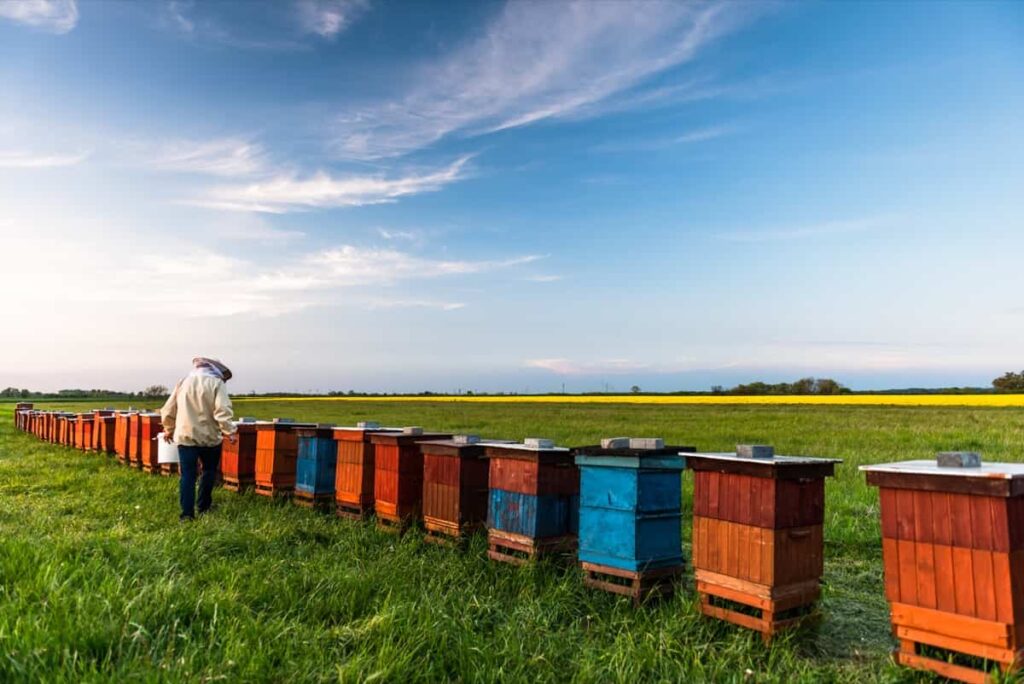
Consider accessibility and safety. You want to place your hives in an area that is easily accessible for inspections, maintenance, and honey harvesting. At the same time, ensure that the location is safe from potential disturbances or hazards such as strong winds or predators. Additionally, consider sun exposure. Bees thrive in areas with plenty of sunlight as it helps regulate hive temperature and aids in honey production. Select a place that receives at least six hours of direct sunlight daily.
Selecting the Appropriate Beehive Type for Dutch Conditions
When it comes to beekeeping in the Netherlands, selecting the appropriate beehive type is crucial for ensuring the well-being and productivity of your bees. One popular beehive option for Dutch beekeepers is the Langstroth hive. This type of hive consists of stacked boxes with removable frames, allowing for easy inspection and management of the colony.
The Langstroth design provides ample space for expansion, making it suitable for larger colonies. Another option is the top-bar hive, which features horizontal bars instead of vertically stacked frames. This design allows bees to build their combs naturally without restrictions. Top bar hives are known for their simplicity and ease of use, making them a great choice for beginner beekeepers.
Acquiring Honeybees and Queens for Your Beekeeping Venture in the Netherlands
One option is purchasing package bees, typically three pounds of worker bees and a queen. These packages are usually imported from countries like Italy or Germany. Another option is buying nucleus colonies, also known as nucs. Nucs are small, established colonies with broods, workers, and a mated queen. You can try catching swarms or luring feral colonies into hive boxes if you prefer a more natural approach.
However, this method can be unpredictable and may require some patience. Ensuring that the bees you acquire come from reputable sources with healthy colonies is important. When selecting queens for your beekeeping in the Netherlands, consider qualities such as docility, disease resistance, productivity, and winter hardiness. It’s advisable to choose locally adapted queens suited for Dutch conditions.
Dutch Beekeeping Associations and Networks
Dutch Beekeeping Associations and Networks are valuable resources for beekeepers in the Netherlands. By joining these associations, beekeepers can benefit from networking opportunities, knowledge sharing, and support from experienced professionals. One prominent association is the Dutch Beekeepers Association (NBV), active since 1897. They offer various services to their members, including educational programs, workshops, and access to expert advice.
In case you missed it: Beekeeping Management Practices: Season-wise Management of Honey Bee
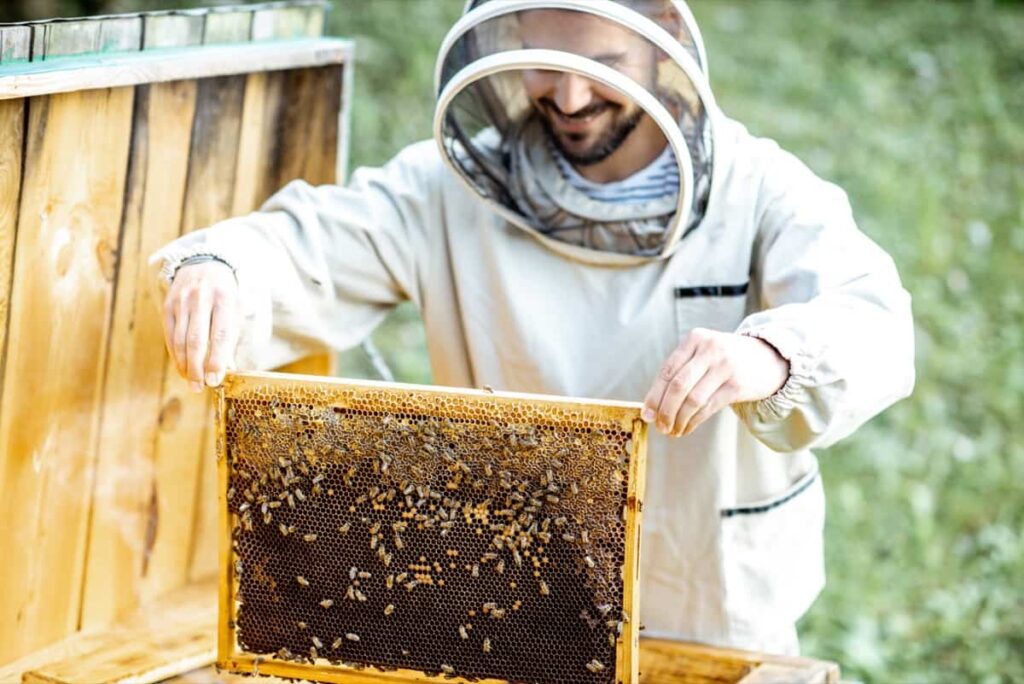
Another important network for Dutch beekeepers is Imkers Nederland. This organization focuses on promoting sustainable beekeeping methods and raising awareness about the crucial role of bees in our ecosystem. They provide training courses and publications and organize regional meetings where members can exchange ideas and experiences.
Necessary Equipment and Tools for Beekeeping in the Netherlands
Firstly, you will need a protective suit or jacket with a veil to keep yourself safe from bee stings. This is especially important during hive inspections and honey extraction. A smoker is another crucial tool for beekeepers. It helps calm down bees by emitting smoke, making it easier to work with them without causing too much disturbance. Next, you’ll need a hive tool. This handy instrument is used to pry apart hive components, scrape off excess propolis or wax, and remove frames during inspections.
To handle the frames filled with honeycombs, you’ll require a pair of gloves. Choose lightweight gloves that provide enough dexterity while protecting your hands from stings. Other equipment includes beehive boxes (which can vary in size), frames (where bees build their comb), feeders (for supplemental feeding), queen excluders (to confine the queen bee), and pollen traps (used to collect pollen).
Setting Up and Maintaining Your Beehives in the Netherlands
How to start beekeeping in the Netherlands? To begin, you must select an appropriate location for your hives. Select a place that receives sunlight and is protected from strong winds. It’s also important to ensure easy access for yourself and the bees. Next, consider which type of beehive will best suit Dutch conditions. Popular options include Langstroth hives, top bar hives, and Warré hives. Once you’ve acquired your honeybees and queens, it’s time to introduce them to their new homes.
Regular maintenance is key to keeping your bee colonies healthy. Inspect the hives weekly during warm weather to check for disease or pests such as varroa mites. Keep an eye on honey production as well. Providing proper nutrition is essential for colony survival. Ensure abundant sources of nectar-rich flowers are nearby, especially during springtime when bees are most active. Additionally, provide a water source within proximity to prevent dehydration.
Ensuring Proper Nutrition and Water Supply for Your Bees in the Netherlands
It is crucial for the health and well-being of your bees in the Netherlands. Bees require diverse nectar and pollen sources to meet their nutritional needs. One way to provide adequate nutrition is by planting various flowering plants that bloom at different times throughout the year. This will ensure a continuous supply of food for your bees. Native wildflowers such as clover and lavender are excellent choices as they attract pollinators and offer abundant nectar.
In case you missed it: Beekeeping in South Africa: Requirements, License, Cost, and Training to Start
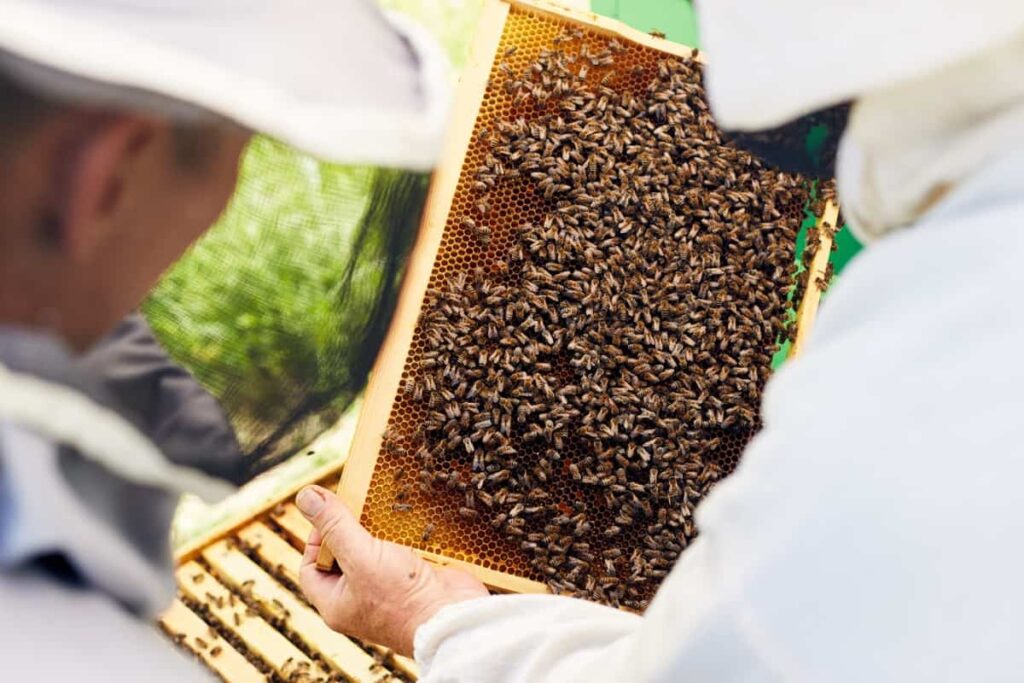
In addition to sufficient nutrition, access to clean water is essential for bees. They use it for hydration and in various hive activities like cooling the colony during hot weather. You can create water sources by placing shallow bowls or trays filled with fresh water near your hives. It’s important to regularly monitor the food stores in your hives to ensure they have enough reserves for winter survival.
Dutch Weather Patterns and Their Impact on Beekeeping
The Netherlands is known for its ever-changing weather patterns, with mild summers and cool winters. These fluctuations can have an impact on beekeeping in the Netherlands. When bees are most active in the spring and summer, the Dutch climate provides abundant nectar-producing flowers. However, sudden temperature drops or heavy rainfall can limit their foraging opportunities. This may lead to reduced honey production and challenges in maintaining strong colonies.
In contrast, during winter months, bees enter a dormancy called “winter clustering.” They form tight clusters within the hive to conserve heat and survive cold temperatures. The relatively mild winters in the Netherlands allow bees to remain active throughout the season without requiring excessive food stores. Extreme heatwaves or prolonged rain spells may require shade or additional shelter for hives.
Local Regulations and Requirements for Beekeeping in the Netherlands
These regulations are implemented to ensure the health and safety of both bees and humans and maintain the integrity of local ecosystems. Before starting your beekeeping venture in the Netherlands, it is crucial to familiarize yourself with these regulations. In the Netherlands, you must register your apiary with the local authorities. This registration helps keep track of beehive locations and enables officials to monitor disease outbreaks or other potential risks.
Another important regulation concerns hive inspection. Dutch law mandates regular inspections by authorized veterinarians or trained officers from designated organizations. These inspections help identify signs of diseases or pests early on so that appropriate measures can be taken promptly. Furthermore, keeping records is essential for compliance purposes. As a beekeeper in the Netherlands, you should maintain accurate documentation regarding hive management activities such as feeding schedules, medication administration (if necessary), and emergency treatments.
Managing Pests and Diseases in Your Dutch Beehives
The most common pests Dutch beekeepers encounter include Varroa mites, wax moths, small hive beetles, and ants. Regular inspections of your hives are essential to detect any signs of infestation early on. Integrated Pest Management (IPM) strategies are widely recommended as they focus on prevention rather than relying solely on chemical treatments.
Maintaining good hive hygiene is also critical for disease prevention. Regularly cleaning equipment, replacing old comb, and avoiding overcrowding can help reduce the risk of bacterial infections such as foulbrood. Additionally, working closely with local beekeeping associations and networks can provide valuable support in identifying potential threats and implementing appropriate control measures specific to the Dutch context.
In case you missed it: Backyard Beekeeping Cost and Tips for Reducing Backyard Beekeeping Costs
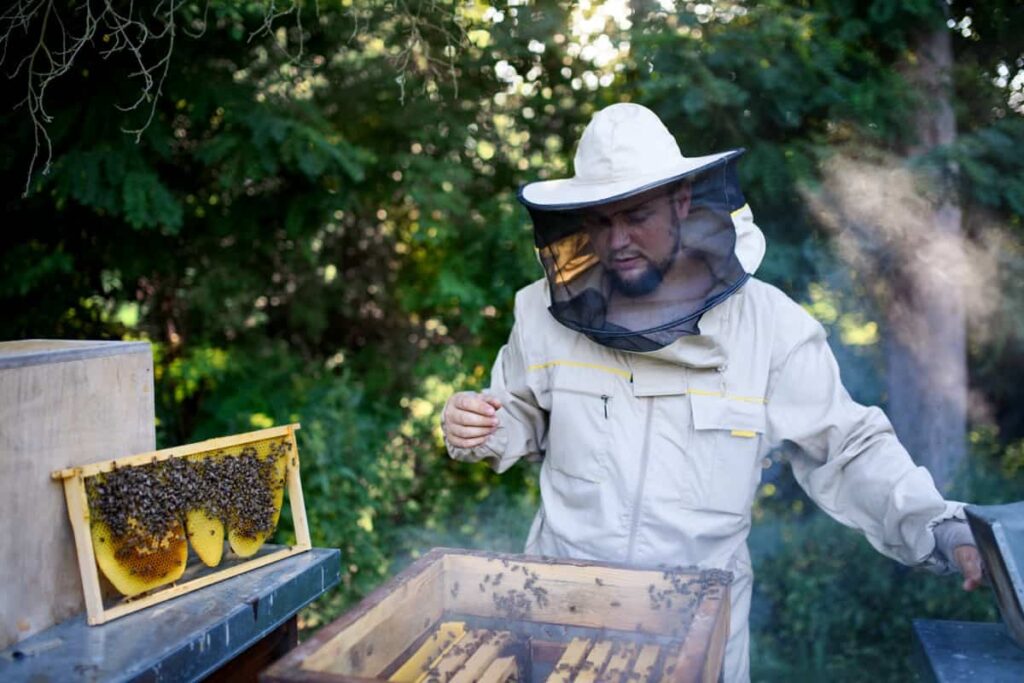
Monitoring and Assessing Hive Health in the Netherlands
Beekeepers in the Netherlands need to ensure the well-being of their bees and the success of their honey bee farming business. Regular inspections are important to find signs of disease, pests, or other issues that could impact colony health. During these inspections, beekeepers should closely observe the behavior and appearance of the bees. In addition to visual observations, monitoring tools such as varroa mite screens and sticky boards can be used to check for pest infestations.
These can help determine if treatment is needed to protect the colony from harmful parasites. Beekeepers may need to submit samples from their hives to a designated laboratory for analysis. By diligently monitoring and assessing hive health in the Netherlands, beekeepers can proactively prevent problems before they become major threats. This promotes stronger colonies and increases the chances of a successful honey harvest each season.
Harvesting Honey and Other Bee Products in the Netherlands
Timing is important when it comes to harvesting honey. You must wait until the bees have capped off their cells with wax, indicating that the honey is fully ripened. This generally occurs during the summer months when nectar flow peaks. You will need equipment such as an uncapping knife or fork, a centrifugal extractor, and strainers to extract the honey from your frames. Carefully remove each frame from the beehive and scrape off the wax caps before placing them in the extractor.
Once extracted, you can filter out impurities using fine mesh strainers or cheesecloth. This ensures that the final product is free from debris. Bees also produce other valuable products besides honey, such as beeswax and propolis. Beeswax can be used for making candles or beauty products like lip balms and lotions. Always leave enough honey for your bees to have sufficient stores for winter survival. Harvesting should not compromise their well-being or food supply. These are the major steps required to start beekeeping in the Netherlands.
Marketing and Selling Your Dutch Honey and Bee Products
With the increasing demand for organic, locally sourced products, there is a great opportunity to showcase your honey’s unique flavors and benefits. To effectively market your honey and bee products in the Netherlands, it’s important to highlight their distinguishing features. One effective strategy is participating in local farmers’ markets or food festivals where you can directly engage with potential customers. In addition to offline marketing efforts, online presence is crucial in today’s digital age.
Collaborating with other local businesses, such as bakeries, restaurants, or health food stores, can boost sales by offering exclusive partnerships or product placement opportunities. This expands distribution channels and helps build credibility for your brand among discerning consumers who value sustainable and ethically produced goods. Additionally, consider incorporating eco-friendly materials into your packaging choices to align with sustainable practices associated with beekeeping.
Beekeeping Course in the Netherlands
The Netherlands offers various beekeeping courses that can help you get started on your journey as a beekeeper. These courses are designed to provide aspiring beekeepers with the knowledge and skills they need to manage their hives successfully. A beekeeping course in the Netherlands typically covers hive management, honey production, pest control, and disease prevention. You will also learn about the types of honey bees in the Netherlands and their unique characteristics.
In case you missed it: 11 Best Beekeeping Suits for Men and Women: Prices Included for Beekeepers in the USA
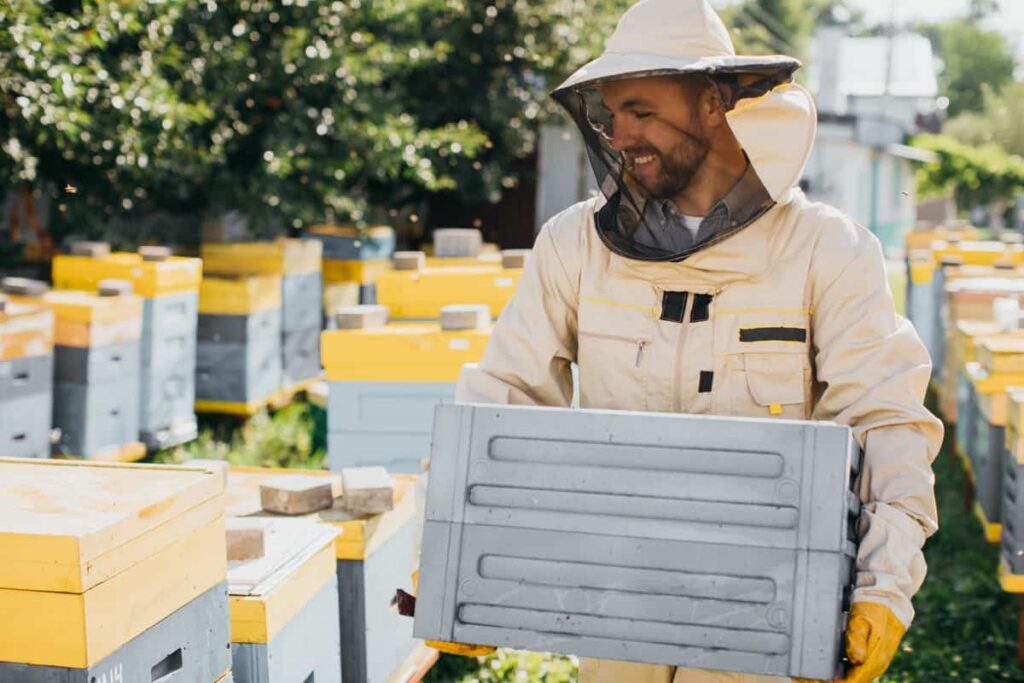
One popular option is the beginner’s course offered by local beekeeping associations. These courses usually consist of both theoretical lessons and practical hands-on experience. Attending a beekeeping course is educational and an excellent opportunity to connect with individuals who share your passion for bees. It allows you to join a community to exchange ideas, seek advice, and collaborate on projects.
Summary of Beekeeping in the Netherlands
| Steps to Start Beekeeping | Tips and Conditions |
| Choosing the Right Location | Select a location with ample forage and protection from strong winds |
| Selecting Beehive Type | Langstroth, Top-Bar, or Warre hives |
| Acquiring Honeybees | Source healthy honeybee colonies or packages from reputable breeders |
| Joining Beekeeping Associations | Local associations like Nederlandse Bijenhouders Vereniging (NBV) for support and guidance |
| Gathering Equipment | Hive bodies, frames, protective gear, smokers, feeders, etc |
| Common Pests | Varroa mites, wax moths, small hive beetles, and ants |
| Pest control | Regularly cleaning equipment, replacing old comb, and avoiding overcrowding |
| Ensuring Nutrition | Plant diverse nectar-rich flowers nearby and provide clean water sources close to the hives |
Conclusion
Beekeeping is not only essential for the environment but also brings economic advantages. Producing honey and other bee products allows small-scale farmers to generate income while promoting local entrepreneurship. Dutch honey is highly regarded for its quality worldwide, making it a sought-after product domestically and internationally. Therefore, this is a guide to starting beekeeping in the Netherlands.
- Management Pests and Diseases in Your Cotton Field
- Sheep Farming Business Plan for Beginners
- Aquaponic Farming at Home: A Step-By-Step Guide
- Profitable Village Farming Business Ideas in 2024
- High-Yield Aquaculture: Fast-Growing Fish for Farming
- Effective Fish Pond Construction Techniques for Beginners
- Irrigation and Water Management in Pineapple Farming
- Blossom to Harvest: Mastering Flowering and Pollination in Papaya Farming
- Pig Fattening Essentials: From Selection to Sale for Beginners
- Raising Wagyu Cattle: A Complete Guide for Premium Beef Production
- Soil Types and Their Water Holding Capacity
- Optimizing Irrigation Schedules for Coconut Groves for Enhanced Yield
- Espresso Your Garden: Coffee Grounds for Healthier Acid-Loving Plants
- The Best Soil Mix for Snake Plants: How to Mix Your Own Snake Plant Soil
- Green Thumb Success: Expert Tips for Cultivating Greenhouse Beans All Year Round
- Bloom All Year Round: The Ultimate Guide to Indoor Hyacinth Care
- Eco-Friendly Gardening: How to Make Liquid Fertilizer from Kitchen Waste
- Ultimate Guide to Grow Anise in Pots: Explore Seed Propagation to Harvesting
- Guide to Raising Chester White Pigs: Discover Breed Facts to Growth Management
- Mastering the Elegance: The Ultimate Guide to Weeping Cherry Tree Care, Planting, and Maintenance
- Ultimate Guide to Planting Garlic in Grow Bags: Growing Strategies for Beginners
- How to Fix Spider Plant Leaf-Related Problems: Natural and Organic Remedies
- 10 Reasons Why Your Tulsi Plant is Shedding Leaves: Home Remedies and Solutions
- Optimizing Growth and Yield: The Advantages of Palm Bunch Ash Fertilizer
- Utilizing Neem Oil Extract as a Natural Pesticide for Hydrangea
- From Soil to Harvest: Various Ways in Which Farmers Can Use AI Tools
- Steps to Encourage and Induce Citrus Flowers: A Comprehensive Guide
- How to Fix Snake Plant Leaf-Related Issues: Natural and Organic Remedies
- Transform Your Garden into a Fragrant Oasis with Raat Ki Rani (Night Blooming Jasmine)
- Discover the Ideal Chicken Breeds for Philippine Farms
- How to Create a Poultry Egg Farm Business Plan for Profits
- Grow Lemon Cucumbers Like a Pro: Insider Techniques for Bountiful Yields
- Ultimate Guide to Caring for Your Pink Princess Philodendron: Tips for Thriving Variegation
- Areca Nut Profit Per Acre: Calculating Yield and Cost of Cultivation
- How Kaveri Chicken is Becoming a More Profitable Breed in Indian Backyards
- Transform Your Barn: 9 Steps to Convert a Horse Stall into a Chicken Coop
